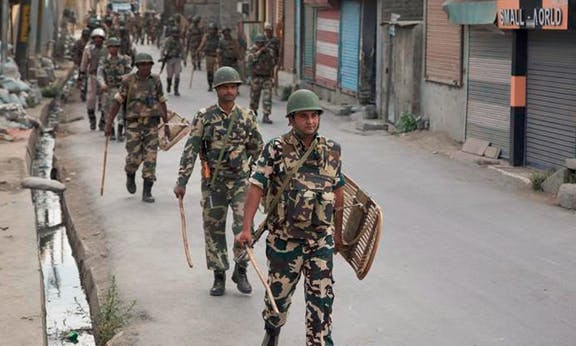The siege of Kashmir and its struggle for self-determination

The Kashmir Valley was engulfed by mass protests after 22-year-old Burhan Muzaffar Wani was killed in clashes with Indian security forces in July. Wani was a commander of the Hizbul Mujahideen, one of several separatist groups demanding self-determination and fighting some 700,000 Indian soldiers deployed throughout Jammu and Kashmir.
More than 300,000 people attended Wani’s funeral in Tral in the Pulwama district. The Indian government, led by prime minister Narendra Modi’s Bharatiya Janata Party (BJP), imposed a media blackout and curfew for 53 days to match the scale of protests from the countryside to the cities. Days after Wani's death, some 35 people were reportedly shot dead.
“The military occupation in Kashmir is spatially organised and underpinned fundamentally by a logic of ordered disorder: constricting political expression and inflicting doses of violence on people on a regular basis”, Kashmiri activist and City University of New York PhD candidate Mohamad Junaid told Red Flag.
“[India] has made violence an endemic reality … Instead of seeing Kashmir as a question of political justice, they see it as a law and order issue. This is the main reason people have taken to [the] streets. They are left with really no choice, as India has launched a full scale assault on the population.”
On 8 October, a 13-year-old boy from Srinagar reportedly died from injuries sustained in clashes with Indian security forces, taking the death toll to 91. In the last three months, more than 7,000 civilians have been injured. Indian security forces have used pellet gun cartridges more than 2,000 times to quash protests, with many protesters subsequently blinded, according to Al Jazeera.
“The series of demonstrations [in Jammu and Kashmir] ... was less about Burhan Wani and more about killings of numerous young Kashmiri youths”, Akbar Chawdhary, an All India Student Association activist and PhD candidate at Jawaharlal Nehru University (JNU), told Red Flag. “We stand in solidarity with youth fighting on the streets and braving the pellets. It’s high time to recognise this as a political problem demanding a political solution, which in our opinion is the right to self-determination of the Kashmiri people.”
This is the worst repression since 2010, when 112 civilians were killed by Indian security forces and Jammu and Kashmir police firing live ammunition at youths calling for total demilitarisation of the region.
A contested history
In August 1947, following the end of British colonial rule over the Indian subcontinent, partition was enacted: India for Hindus, and an East and West Pakistan for Muslims. More than 1 million people were killed as a result of communal violence, internal displacement and mass migration.
Kashmir was an independent princely state ruled by autocratic Hindu maharajah Hari Singh. Its sovereignty was premised on loyalty to the British Empire. Singh sought to remain independent until October 1947, when armed tribesmen from the Kashmiri western districts and North-West Frontier Province of West Pakistan raided parts of Kashmir with West Pakistani military backing.
With support from the National Conference, the largest secular progressive political party in Kashmir, Singh signed the Instrument of Accession and surrendered control to India in exchange for military aid and ground troops.
Since 1948, Kashmir has been embroiled in the Indo-Pakistan wars of 1947, 1965 and 1999. For Pakistan, a claim to Kashmir lends legitimacy and continuity to the theory that, following partition, Indian Muslims needed a state of their own. Indian control of Jammu and Kashmir means that it controls a water supply to Pakistan, the world’s most water-stressed nation. Control of the region also lends legitimacy to the claim that India is “the world’s largest democracy”, as the Indian ambassador to the UN, Ajit Kumar, put it to Al Jazeera.
India has rejected holding a UN Security Council plebiscite for Kashmiris to decide whether to join India or Pakistan, or to be an independent state. Pakistan has supported a plebiscite but has never supported the possibility of an independent Kashmir. An estimated two-thirds of people in Jammu and Kashmir want independence.
Political cartoonist and JNU research scholar V. Arun Kumar told Red Flag that Kashmir is “the Palestine of South Asia”. India has bought arms from Israel since the 1960s and is one of the Zionist state’s biggest clients, spending some US$10 billion over the past decade. Indian police have also been receiving training in Israel for “anti-terror” operations. Modi will visit Israel in 2017 to mark the 25th anniversary of full diplomatic relations.
In 2008, non-violent protests were sparked after the Indian government granted land near an ecologically sensitive region in Jammu and Kashmir to a Hindu religious trust that wanted to erect permanent facilities for tens of thousands of pilgrims visiting for two months every year.
Modi’s BJP also advocates population transfers to push Kashmir’s majority Muslim population into Pakistan. It also wants to develop sainik [army] colonies, establish separate cities for Kashmiri Hindus and get rid of legal hurdles that prevent Indians and Indian industrialists from purchasing land in the region.
Two civilians were killed after a curfew was imposed during the Muslim holiday of Eid al-Adha last month. Kashmiri resident Amir told Al Jazeera, “Today India has broken all its records, but we want to tell them that no matter how you oppress us, we will not accept defeat. We will achieve freedom”.